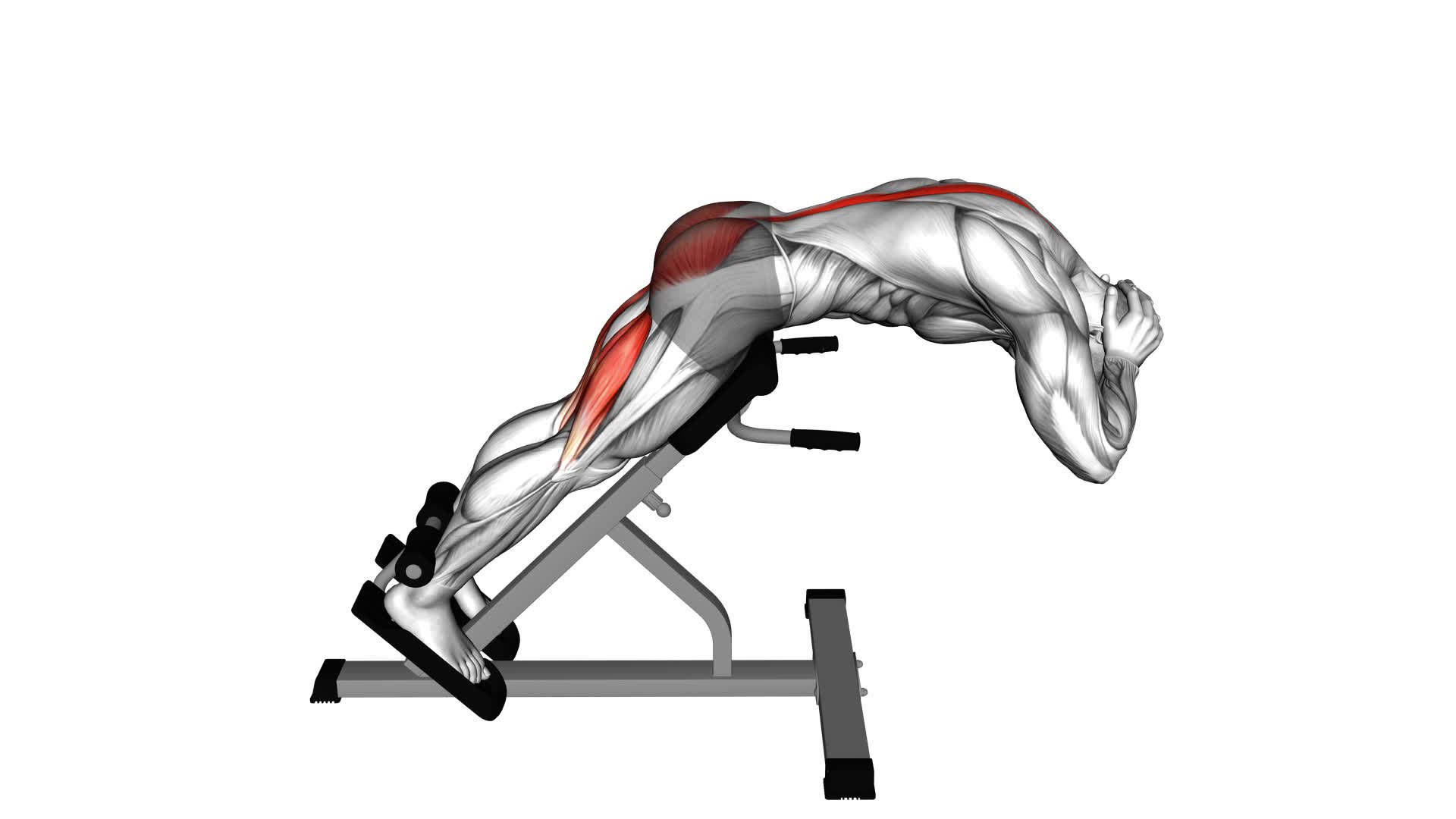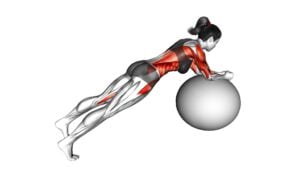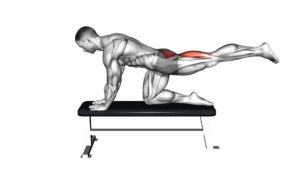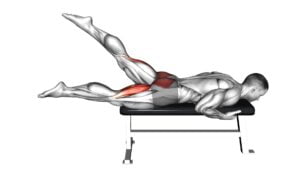Rounded Back Extension – Video Exercise Guide & Tips

Looking to improve your back strength and flexibility? Check out this video exercise guide and tips for rounded back extensions.
Watch This Exercise Video
You'll learn the benefits of this exercise, proper form and technique, common mistakes to avoid, variations and progressions, and how to incorporate it into your workout routine.
Get ready to strengthen and stretch your back like never before!
Key Takeaways
- Rounded back extensions target muscles in the lower back, improve posture and stability, engage glutes and hamstrings, and reduce the risk of lower back pain.
- Proper form and technique include maintaining a neutral spine, engaging core muscles, breathing properly, starting with a gentle range of motion, and avoiding excessive momentum or swinging.
- Common mistakes to avoid include using momentum instead of engaging back muscles, lifting the upper body too high causing hyperextension, rounding shoulders or tucking chin, improper breathing technique, and focusing on proper technique to avoid injury.
- Variations and progressions of rounded back extensions include weighted, single-leg, Swiss ball, and banded extensions, which can challenge muscles and improve strength and flexibility.
Benefits of Rounded Back Extensions
You can experience several benefits from performing rounded back extensions. This exercise primarily targets the muscles in your lower back, including the erector spinae, multifidus, and quadratus lumborum. By activating and strengthening these muscles, rounded back extensions can help improve your posture and stability. Additionally, this exercise also engages your glutes and hamstrings, which can contribute to better overall strength and balance.
One of the main benefits of rounded back extensions is the potential to reduce the risk of lower back pain. Stronger muscles in your lower back can provide better support to your spine, reducing the likelihood of injuries and discomfort. Regularly performing this exercise can also improve your core strength, which plays a significant role in maintaining a healthy back.
However, it's essential to be cautious when performing rounded back extensions. If you have a history of lower back problems or are experiencing any pain or discomfort, it's advisable to consult with a healthcare professional before attempting this exercise. Proper form and technique are crucial to ensure the safety and effectiveness of rounded back extensions.
Transitioning into the subsequent section about 'proper form and technique', let's explore how to perform rounded back extensions correctly to maximize the benefits and minimize the risks.
Proper Form and Technique
To ensure proper form and technique during rounded back extensions, it's important to focus on maintaining a neutral spine throughout the exercise. This means keeping your back straight and avoiding any excessive rounding or arching. Here are some key tips to help you perform rounded back extensions with proper form:
- Importance of core engagement: Engaging your core muscles is crucial for stabilizing your spine and protecting your lower back. Before starting the exercise, activate your core by drawing your belly button towards your spine.
- Proper breathing technique: When performing rounded back extensions, it's important to breathe properly. Inhale deeply before initiating the movement, and exhale as you lift your upper body off the ground. This will help you maintain control and stability throughout the exercise.
- Start with a gentle range of motion: Begin with a small movement and gradually increase the range of motion as you become more comfortable and confident. This will allow you to maintain proper form and avoid straining your back.
- Avoid excessive momentum: It's important to perform rounded back extensions in a controlled manner. Avoid using excessive momentum or swinging your body to lift yourself up. Instead, focus on using your back muscles to initiate the movement.
Common Mistakes to Avoid
To avoid compromising your form and risking injury during rounded back extensions, it's important to be aware of common mistakes that should be avoided.
One common mistake is using momentum to lift your upper body instead of engaging the muscles in your back. This not only reduces the effectiveness of the exercise but also increases the risk of straining your lower back.
Another mistake is lifting your upper body too high, which can lead to hyperextension of the spine and potentially cause injury. It's important to maintain control and lift only until your upper body is in line with your hips.
Additionally, avoid rounding your shoulders or tucking your chin towards your chest, as this can strain your neck and compromise your form.
Lastly, make sure to breathe properly throughout the exercise, inhaling as you lower your body and exhaling as you lift.
By avoiding these mistakes and focusing on proper technique, you can maximize the benefits of rounded back extensions while minimizing the risk of injury.
Now, let's move on to explore variations and progressions of this exercise.
Variations and Progressions
There are several variations and progressions you can incorporate into the rounded back extension exercise to challenge your muscles and continue to improve your strength and flexibility. Here are some advanced rounded back extension variations and progressions for rounded back extensions that you can try:
- Weighted Rounded Back Extension: Hold a dumbbell or a weighted plate against your chest while performing the exercise. This adds resistance and increases the difficulty of the exercise, making your muscles work harder.
- Single-Leg Rounded Back Extension: Lift one leg off the ground while performing the exercise. This variation increases the demand on your core and posterior chain muscles, providing a greater challenge to your balance and stability.
- Swiss Ball Rounded Back Extension: Perform the exercise on a Swiss ball instead of a bench. This unstable surface engages your core muscles even more, enhancing your balance and coordination.
- Banded Rounded Back Extension: Attach a resistance band around your upper back and hold the ends of the band in your hands. This variation adds resistance throughout the movement, making it more challenging for your back muscles.
Incorporating these variations and progressions into your rounded back extension routine will help you continue to progress and achieve greater strength and flexibility. Remember to start with proper form and gradually increase the difficulty as your muscles become stronger.
Tips for Incorporating Rounded Back Extensions Into Your Workout Routine
To effectively incorporate rounded back extensions into your workout routine, focus on consistency and gradual progression. Consistency is key in any exercise program, as it allows your body to adapt and improve over time. Aim to perform rounded back extensions at least two to three times per week to maximize results and prevent injury. Gradual progression is also important to ensure that your muscles continue to be challenged and stimulated. Start with a lighter weight or lower intensity and gradually increase as your strength and endurance improve.
When performing rounded back extensions, it's crucial to prioritize injury prevention. Maintain proper form throughout the exercise, keeping your core engaged and your back straight. Avoid excessive rounding of the back, as this can put unnecessary strain on your spine. Additionally, be mindful of the weight or resistance you use, starting with a manageable load and gradually increasing as your muscles adapt.
To enhance muscle activation during rounded back extensions, focus on squeezing your glutes and engaging your lower back muscles. This will help to maximize the benefits of the exercise and promote overall strength and stability in the posterior chain. Remember to breathe consistently throughout the movement, exhaling as you lift and inhaling as you lower.
Incorporating rounded back extensions into your workout routine can be a valuable addition for strengthening your lower back and improving posture. By following these tips for consistency, gradual progression, injury prevention, and muscle activation, you can effectively incorporate this exercise into your fitness regimen.
Frequently Asked Questions
How Many Repetitions Should I Do for Rounded Back Extensions?
For rounded back extensions, the number of repetitions you should do depends on your fitness level and goals. It's generally recommended to start with 8-12 reps per set. As you become stronger, you can increase the number of reps or sets.
Rounded back extensions are beneficial for improving posture, strengthening your lower back and glutes, and enhancing core stability. They can be a valuable addition to your workout routine.
What Are the Muscles Targeted During Rounded Back Extensions?
During rounded back extensions, multiple muscles are targeted. These include the erector spinae, which helps with spinal extension, and the gluteus maximus, which aids in hip extension. These exercises also engage the hamstrings, which assist in knee flexion.
Performing rounded back extensions regularly can lead to several benefits. These include improved posture, increased strength in the back and glutes, and reduced lower back pain.
Can Rounded Back Extensions Help With Improving Posture?
Rounded back extensions can be beneficial for improving posture. By strengthening the muscles in your back and core, these exercises can help you maintain a more upright position.
There are variations of rounded back extensions that target different muscle groups, allowing you to customize your workout.
Incorporating these exercises into your routine can contribute to better posture and overall spinal health.
Are There Any Modifications for Individuals With Lower Back Pain or Injuries?
If you have lower back pain or injuries, there are modifications you can make to the rounded back extension exercise. These modifications are beneficial for beginners as they help reduce strain on the lower back.
By adjusting the range of motion and using proper form, you can still reap the benefits of rounded back extensions without aggravating your condition.
It's important to consult with a professional or physical therapist to ensure you're performing the exercise correctly and safely.
Can Rounded Back Extensions Be Performed With Weights or Resistance Bands?
Yes, rounded back extensions can be performed with weights or resistance bands. Adding weight to the exercise can increase the intensity and challenge your muscles even more. It can help strengthen your back and improve your posture.
Resistance bands are a great alternative if you don't have access to weights. They provide constant tension throughout the movement, targeting your back muscles effectively.
Incorporating weights or resistance bands into rounded back extensions can enhance the benefits of this exercise.
Conclusion
Incorporating rounded back extensions into your workout routine can offer numerous benefits, including improved posture, increased core strength, and enhanced spinal flexibility. By maintaining proper form and technique, you can avoid common mistakes and maximize the effectiveness of this exercise.
Additionally, exploring variations and progressions can help you continually challenge your muscles and progress towards your fitness goals. Remember to consult with a fitness professional before incorporating any new exercise into your routine.

Author
Years ago, the spark of my life’s passion ignited in my mind the moment I stepped into the local gym for the first time. The inaugural bead of perspiration, the initial endeavor, the very first surge of endorphins, and a sense of pride that washed over me post-workout marked the beginning of my deep-seated interest in strength sports, fitness, and sports nutrition. This very curiosity blossomed rapidly into a profound fascination, propelling me to earn a Master’s degree in Physical Education from the Academy of Physical Education in Krakow, followed by a Sports Manager diploma from the Jagiellonian University. My journey of growth led me to gain more specialized qualifications, such as being a certified personal trainer with a focus on sports dietetics, a lifeguard, and an instructor for wellness and corrective gymnastics. Theoretical knowledge paired seamlessly with practical experience, reinforcing my belief that the transformation of individuals under my guidance was also a reflection of my personal growth. This belief holds true even today. Each day, I strive to push the boundaries and explore new realms. These realms gently elevate me to greater heights. The unique combination of passion for my field and the continuous quest for growth fuels my drive to break new ground.







